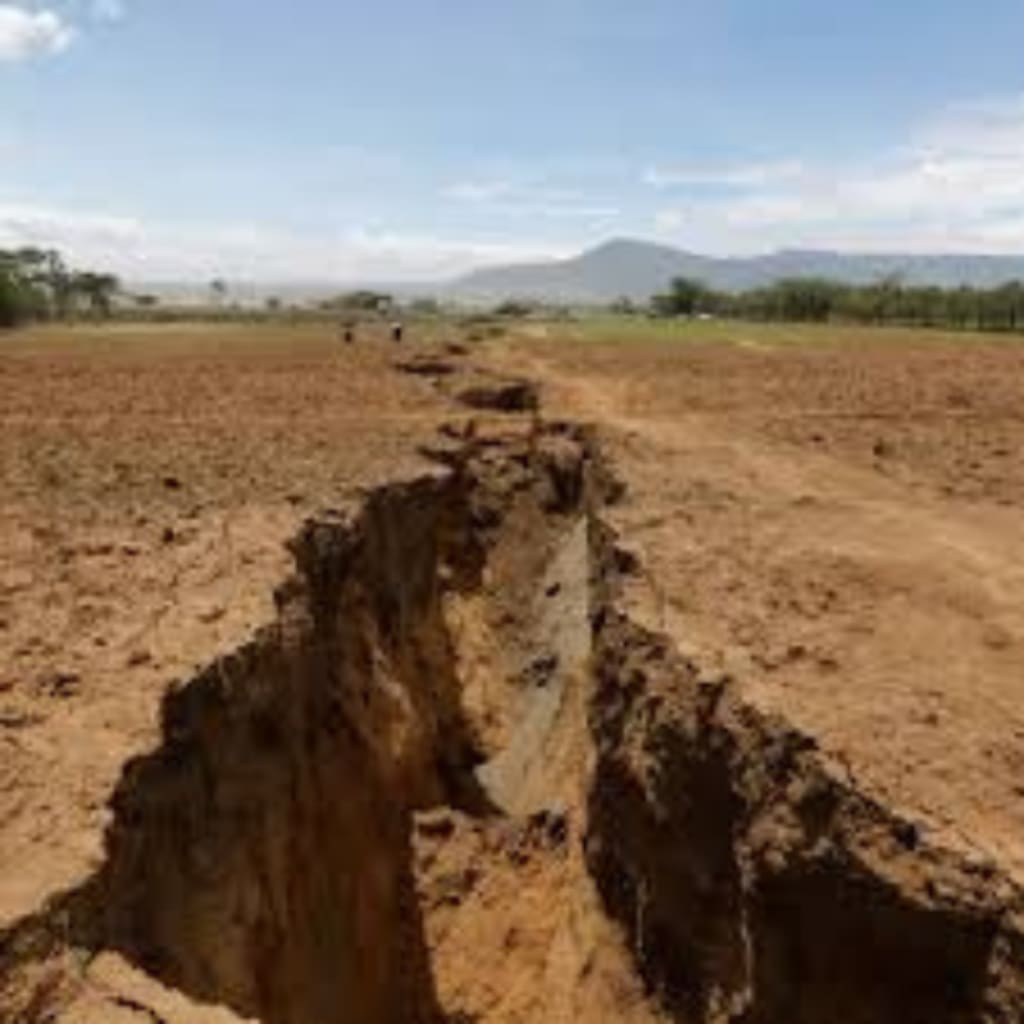Africa is Splitting into 2 continents and most people are not aware
Africa into 2 continents

Africa is Splitting into 2 continents and most people are not aware
Africa is undergoing a continental rift, causing the continent to split into two or more continents. This phenomenon is a normal occurrence worldwide, as every continent in our world has formed due to rifts and shifting of tectonic plates. The Earth's outer crust, which is made up of 15 to 20 tectonic plates, is constantly moving apart or toward each other, forming continents, islands, oceans, and seas. The East African Rift, a network of valleys extending about 2175 miles from the Red Sea to Mozambique, is a result of this separation.
The Somalian plate in the East is moving Eastward away from the larger and older part of the continent, the Nubian plate, and the Arabian plate in the north. Both plates are moving away from the Arabian plate in the north, forming a y-shaped Rift system. If the Somalian tectonic plate detaches completely from the larger Nubian plate, the world's second largest continent will split into two. This would be an exciting phenomenon for geologists and scientists, as it would take about 5 to 10 million years for a clean separation.
Particular separation of the Somalian and Nubian plates may lead to the formation of a new sea between the two land masses, including Somalia, Eritrea, Djibouti, Eastern parts of Ethiopia, Kenya, Tanzania, and Mozambique. Countries that will benefit from this rift include landlocked countries like Ethiopia and Uganda, which will benefit from the introduction of a coastline.
The East African Rift, a process of oceanic movement, is causing a new ocean and a separate continent in East Africa. The Gulf of Aden and the Red Sea will flood over the Afar region, creating a new ocean and transforming East Africa into a separate small continent. The rift is growing apart at a rate of about a quarter of an inch every year, and the formation of these rifts is still a subject of debate among geologists and geophysicists. One popular model suggests that increased heat flow from deep inside the Earth causes thermal bulges, which stretch and fracture the outer crust into normal faults. These bulges are caused by heat exerted on the Earth's crust by mantle plumes, which are areas under the continent where magma is hotter than surrounding magma. This heat can cause the overlying crust to melt and thinning, leading to the expansion and fracture of the bulges.
Rift valleys, lowland regions formed when two tectonic plates move apart, are also present in the ongoing rift in Africa. These valleys are often part of triple junctions, where three tectonic plates meet at 120 degrees angles, forming an entire ocean. The Atlantic Ocean is a result of a triple junction, while the Great Rift Valley, a well-known rift valley, is also a significant feature of the rift.
The East African Rift, also known as the Albert Rift or the Lake Albert Rift, is a biodiverse area in Africa with features such as snow-capped mountains, savannas, and high forests. It contains the East African Great Lakes and is one of the most biodiverse areas in Africa. The Gregory Rift, named after the geologist who first mapped it, stretches from the Red Sea and the Arabian Sea downward to Mount Kilimanjaro. It is notable for the Afar Triple Junction, where the Horn of Africa straddles the Red Sea and the Gulf of Aiden in the Arabian Sea. The Gregory Rift has deeper basins with large lakes and sediments, such as Lake Tanganyika and Lake Malawi.
Geologists have observed the East African Rift system to study how ocean basins form on land. The system is an excellent field laboratory to study a modern actively developing Rift system. Rift lakes are formed when fresh water fills up a rift valley, such as the North American Plate's rifting over a billion years ago. Examples of rift lake formations include Lake Baikal in Siberia, the Dead Sea in the Jordan Rift Valley, and the rift valley lakes in Ethiopia and Malawi. These lakes are known for their incredible biodiversity, including freshwater lakes like Lake Baikal and saltwater soda.
Lake Tanganyika, Lake Natron, and Lake Malawi are some of the Rift Valley Lakes in Africa. Lake Tanganyika is located along the coastlines of Burundi, the Democratic Republic of Congo, Tanzania, and Zambia, and is home to hundreds of endemic ticklid fish species. Lake Natron is a shallow alkali-rich soda lake in Tanzania, while Lake Malawi is the third deepest freshwater lake in the world. The region has gained importance for understanding human evolution, with hominid fossil discoveries and the discovery of hominin skeletons like Lucy and Turkana Boy.
Experts believe that the structure and evolution of the Rift led to an environment ideal for life proliferation and increased sensitivity to climate change. The Rift Valley is also a potential power source due to volcanic and tectonic activities. The United Nations environment program is working on a geothermal energy program to convert heat from the Rift Valley's underground activity into electricity through steam wells. However, volcanic and tectonic changes have also caused undesirable situations for the people in the region, such as rising water levels and intense malnutrition and poverty.
About the Creator
Dhiraj Jain
Dhiraj is a cricketer with a dream of becoming an acclaimed author. Fueled by a lifelong love for storytelling,
"joined creative writing courses," "devoted weekends to crafting short stories," etc.






Comments
There are no comments for this story
Be the first to respond and start the conversation.